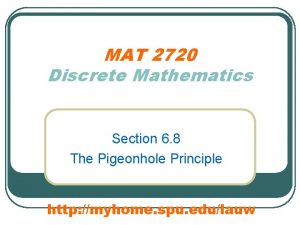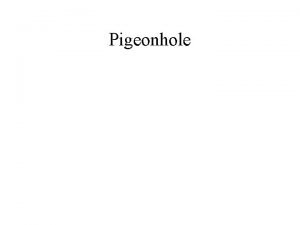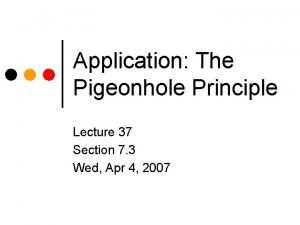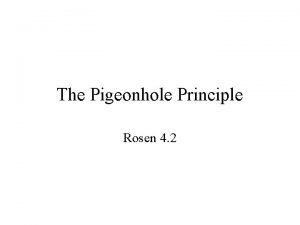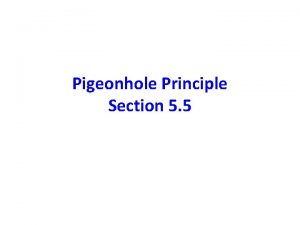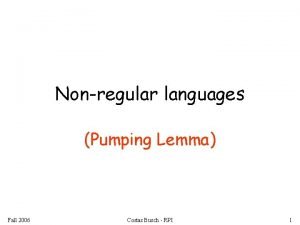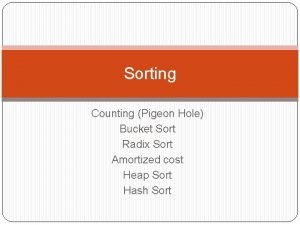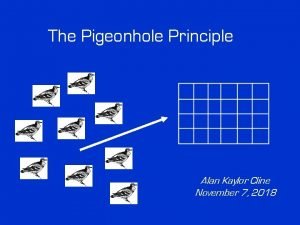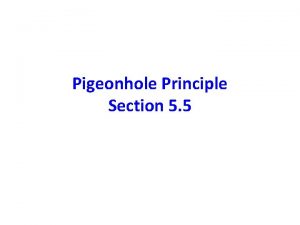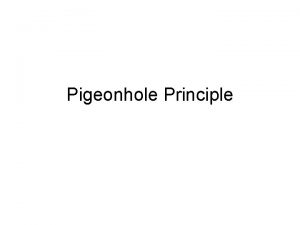Pigeonhole Principle Section 12 3 The Pigeonhole Principle
















- Slides: 16

Pigeonhole Principle Section 12. 3

The Pigeonhole Principle • In words: – If n pigeons are in fewer than n pigeonholes, some pigeonhole must contain at least two pigeons

The Pigeonhole Principle • In math:

The Pigeonhole Principle • • What is a set? a finite set? What is |A|? What is a function? the domain of a function? the codomain of a function? Why say “distinct”?

Other principles related to the pigeonhole principle: • If n objects are put into n boxes and no box is empty, each box has exactly one object. • If n objects are put into n boxes and no box gets more than one object, each box has an object.

Abstract formulation • Let X and Y be finite sets and let f: X Y be a function. 1. If X has more elements than Y, then f is not one-to-one. 2. If X and Y have the same number of elements and f is onto, then f is one-to-one. 3. If X and Y have the same number of elements and f is one-to-one, then f is onto.

Applications of The Pigeonhole Principle • In any group of 8 people, two were born on the same day of the week • What are the “pigeons” and what are the “pigeonholes”? • A = the set of people, B = {Sun, … Sat}, f(a) = the day of the week on which a was born 9/17/2020 7

Generalized pigeonhole principle • If m objects are placed into n boxes, then there is at least one box containing m/n objects – Proof by contradiction. Suppose each box contains less than m/n objects, and there are m objects in total in n boxes. In this case the total number of objects n boxes can hold is at most ( m/n -1)*n which is less than (((m/n)+1)-1)*n, since x < x+1 always. This implies that there are less than m pigeons in n boxes. This is a contradiction. 8

Problems 1. Let S Z+, where |S|=12. Then S contains two elements that have the same remainder upon division by 11. – For any element a of S, (a mod 10} {0, 1, 2, 3, …, 10}. We define the function f: X Y as follows: X = S; Y = {0, 1, 2, 3, 4, 5, 6, 7, 8, 9}; f(a) = a mod 10. Now apply PHP. 2. Example 5. 45 of Grimaldi’s Text Define a function f: X Y where X contains 5 points (pigeon) and Y contains 4 triangles (hole)

Problems (contd. ) 3. 19 darts are thrown onto a dartboard which is shaped as a regular hexagon with side length of 1 unit. Show that there are 4 darts within distance 1. Each triangle is an equilateral triangle. Each side is of length 1. 4. Show that among 200 people, there at least 17 people who are born on the same month. How many pigeons? How many holes? 5. How many students in a class must there be (smallest size) to ensure that 10 students get the same grade (one of A, B, C, D, F, or N)?

Problems (contd. ) 6. Suppose that there are 50 people in the room. Some of them are acquainted with each other, while some are not. Assume that each person has at least one acquaintance. Show that there are two persons in the room who have equal number of acquaintances. (Hints: Each individual can have acquaintances in the range [1. . 49]. Why? )

Problems (contd. ) 7. Consider n distinct numbers a 1, a 2, …, am. Let m = min {a 1, a 2, …, an} and M = max {a 1, a 2, …, an}. We define the gap of of two elements ai and aj to be |ai – aj| if there does not exist any other element ak with ai < ak < aj, otherwise it is 0. Show that there exist two elements in {a 1, a 2, …, an} whose gap is at least (M-m)/(n+1). m a 4 M a 2 a 6 a 3 a 5 a 1 The gap between a 2 and a 6 is the largest; the gap between a 4 and a 6 is zero, since a 2 lies in between a 4 and a 6. (Hint: Partition the interval [m. . M] into n+1 small sub-intervals (holes), each of length (M-m)/(n+1). When n points (pigeons) are placed in the holes, there exists at least one empty hole. )

Problems (contd. ) 8. Seven darts are thrown onto a circular dartboard of radius 10 units. Show that there will be two darts which are at most 10 units apart. 9. 6 computers on a network are connected to at least 1 other computer. Show there at least two computers that have the same number of connections 10. Given m positive integers a 1, a 2, …, am, show that there exists k and l with 0 ≤ k <l ≤ m such that ak+1 + ak+2 + … + al is divisible by m. (Hints: Let Ai = a 1 + a 2 + … + ai. Let Bi = Ai mod m. Define f: X Y where X= {A 1, A 2, …, Am} and Y = {B 1, B 2, …, Bm}, and |X| > |Y|. This implies that there exist indices j and j’ such that Aj mod m = Aj’ mod m. i. e. aj+1 + aj+2 + … + aj’ is divisible by m. )

Problems (contd. ) 11. Problems from the text (Section 12. 3): 1, 2, 3, 5. 6.

A nontrivial example: • A chess master who has 11 weeks to prepare for a tournament decides to play at least one game every day, but he decides not to play more than 12 games during any calendar week. Show that there exists a succession of consecutive days during which the chess master will have played exactly 21 games. • Ans: – Let aj = number of games played on the first j days. – Therefore, 1 < a 2 < … < a 77 ≤ 12 x 11 (why? )

A nontrivial example: Let aj = number of games played on the first j days. Therefore, 1 < a 2 < … < a 77 ≤ 12 x 11 (why? ) Let bj = aj + 21, j= 1, 2, …, 77. Therefore, 21 < b 2 < … < b 77 ≤ 132+21 (why? ) Define a function f : X Y where X = {a 1, a 2, …, a 77, b 1, b 2, …, b 77} Y = {1, 2, 3, …, 153} (the value each aj or bj is at most 153) f(x) = the value of x – There are 154 pigeons and 153 holes. – Hence there exists j and j’ such that aj = bj’. – Thus during days j’+1, j’ +2, …, j the chess player played exactly 21 games. – – –
 Pigeonhole principle exercises
Pigeonhole principle exercises Pigeonhole principle in discrete mathematics
Pigeonhole principle in discrete mathematics State the pigeonhole principle
State the pigeonhole principle Dirichlet box principle
Dirichlet box principle Pigeonhole principle proof
Pigeonhole principle proof Pigeon principle examples
Pigeon principle examples Application of pigeonhole principle
Application of pigeonhole principle Pigeonhole principle
Pigeonhole principle Pigeonhole principle
Pigeonhole principle Pigeonhole principle
Pigeonhole principle Pigeonhole principle
Pigeonhole principle Pumping lemma pigeonhole principle
Pumping lemma pigeonhole principle Pigeonhole sorting
Pigeonhole sorting Pigeonhole
Pigeonhole Pigeonhole
Pigeonhole Hình ảnh bộ gõ cơ thể búng tay
Hình ảnh bộ gõ cơ thể búng tay Ng-html
Ng-html

